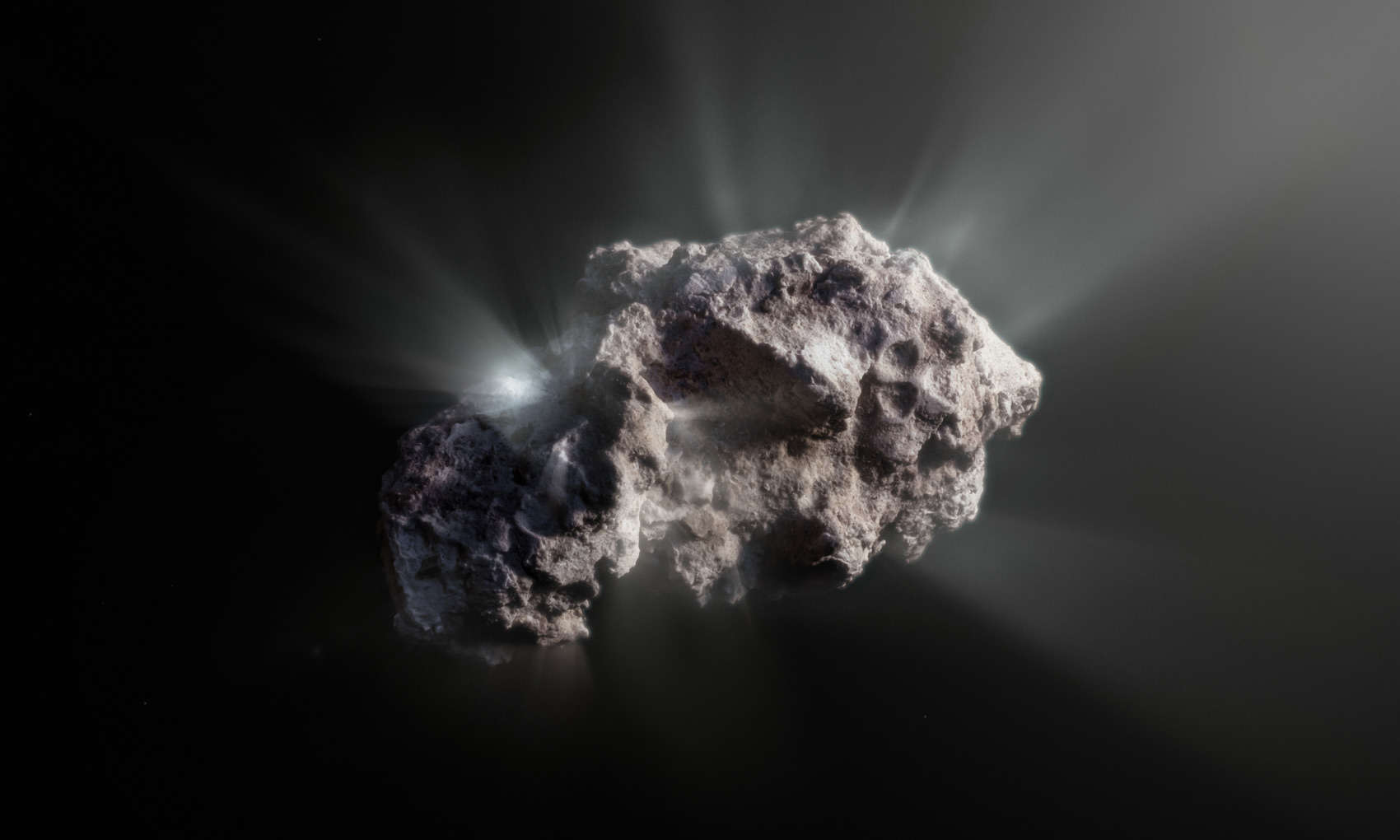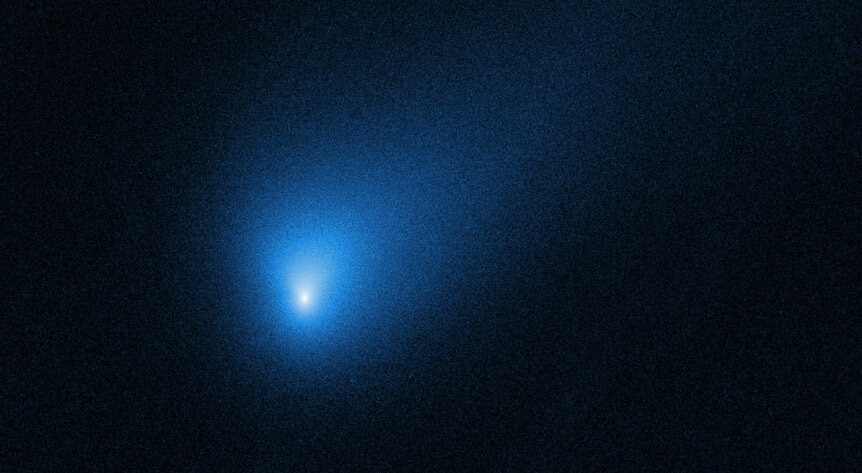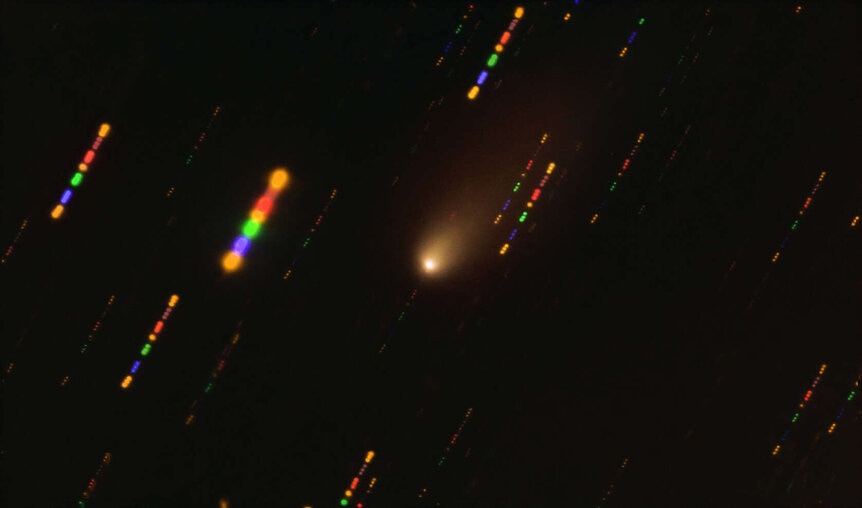Create a free profile to get unlimited access to exclusive videos, sweepstakes, and more!
The interstellar comet Borisov was shiny and new when it passed through our solar system

For a long time, astronomers thought our second alien interstellar visitor*, the comet 2/I Borisov, was rather boring: It looked pretty much like every small comet from our own solar system.
However, now it appears that it was special: It was pristine, almost completely unchanged since it formed, meaning ours was the first solar system it visited closely.
Isn't that nice?
2/I Borisov was discovered by amateur astronomer Gennady Borisov in late August 2019, and it didn't take long before it was found to be very interesting: Literally alien, a comet from another star that had spent countless years traveling through interstellar space before passing the Sun.
It zipped past the Sun in December 2019, getting about 300 million kilometers from it, or just inside the orbit of Mars, before heading back out again on a hyperbolic orbit, a path that is not bound to the Sun (unlike planets which have elliptical orbits, or comets which can be nearly parabolic). Astronomers used telescopes around the planet (and above it) to observe it, hoping to see something bizarre, something strange about it — it's from another star — and what they found was... it's a comet.
I mean, it looked just like any other comet from our own solar system. If it hadn't been screaming through on an interstellar trajectory it wouldn't have been special at all.
That was a little disappointing. I was hoping for kryptonite, or vibranium, or at least a little protomolecule.
However, that's what straight-up images and spectra told us. It turns out polarization tells a different story.
As I recently described for a very different type of object (a supermassive black hole gobbling down the mass of the Earth or two every day):
Light can be thought of a series of waves carrying energy away from an object. Normally, these waves are randomly oriented; if you imagine one like the string of a guitar, you can pluck it so it vibrates up and down, or left and right, or at any angle.
Some phenomena, however, send out waves that are aligned — like strumming a guitar gets the strings all vibrating horizontally. Light waves aligned in this way are said to be polarized.
You may already be familiar with is concept: Light that reflects off metal or glass can be polarized. Polarized sunglasses have filters in them that contain molecules all aligned in one direction, such that when polarized light reflected off horizontal surfaces hits them it gets blocked. Only polarized light aligned with the molecules gets through.
Dust polarizes light as well. The solid part of comet is called nucleus, which is basically frozen ices and dust. When it gets near the Sun it warms up, the ice turns to gas, and dust is blown off the nucleus along with it, forming the fuzzy coma and the long tail.
Sunlight reflected off of those tiny dust grains is polarized, and that can say a lot about the grains, which in turn tell us about what the comet is made of.
Observing Borisov with the Very Large Telescope, scientists found that the polarization of the dust was odd. The way the light was polarized in different colors didn't match the way any other known comet in the solar system polarizes light... except one: Hale-Bopp.
Hale-Bopp was a huge (30–40 km wide nucleus; Borisov is less then 1 km) comet that came through the inner solar system in the 1990s. It was very bright, easily seen by naked eye, and was heavily studied. Its structure and composition indicated it originally formed very far out in the solar system, on the edge of interstellar space, and that at most it had only passed into the inner solar system once. It was a pristine comet.
And Borisov matches it. That indicates it too is pristine, likely ejected into the galaxy by an encounter with a giant planet in its own home solar system before it had a chance to plunge closer in to its star. That also means it likely didn't pass close to any other stars before it got pretty close to our Sun.
Other observations of the comet revealed something else, too. Most comets emit about the same mass of dust as gas when they warm up, kilogram for kilogram. But when Borisov passed the Sun it was blowing off about 200 kilograms of dust per second, while only emitting about 60–70 kg/sec of gas. Such a high dust/gas ratio is extremely unusual for local comets, but did match one. Yup. Hale-Bopp.
Incidentally, the amount of gas and dust blown off of Borisov as it passed the Sun means it shrank by about two meters in size. I think that's just a cool thing to know.
This next part is subtle. Using the ALMA millimeter/submillimeter array, astronomers found that the grains of dust in Borisov were big, likely 1 mm in size or bigger, but compact, not fluffy (so more like icy particles than snowflakes). Again, that's unusual since local comets are fluffy. This implies it formed in the inner part of its home solar system: In early days, lots of pebble-sized pieces of rock and ice were floating around, and could slowly impact a growing comet, compacting it.
However, they also saw that the amount of carbon monoxide and water it emitted changed drastically from before it passed the Sun to after it passed, implying the comet is heterogeneous, like it's made up of differently composed pieces.
This implies some of it formed close in to its star, and some farther out. That in turn means the material from the inner part of this alien solar system was mixed well with stuff from farther out, likely due to the gravitational influence of giant planets. That gives astronomers insight into how another planetary system formed. That's pretty difficult information to obtain otherwise, since we sit light years away from other systems. And it was delivered right to us!
We expect to see more interstellar objects like Borisov to pass us, possibly relatively often. We can learn about them, and maybe even visit them; the European Space Agency is building a mission called Comet Interceptor to do just that. It will achieve very high acceleration and be able to catch up to fast-moving objects that visit from the galaxy at large.
We won't be sitting hundreds of millions of kilometers away for that. We'll have front row seats. What will we learn then?
*The first was 'Oumuamua, which is likely a big ol' chunk of nitrogen ice.





























